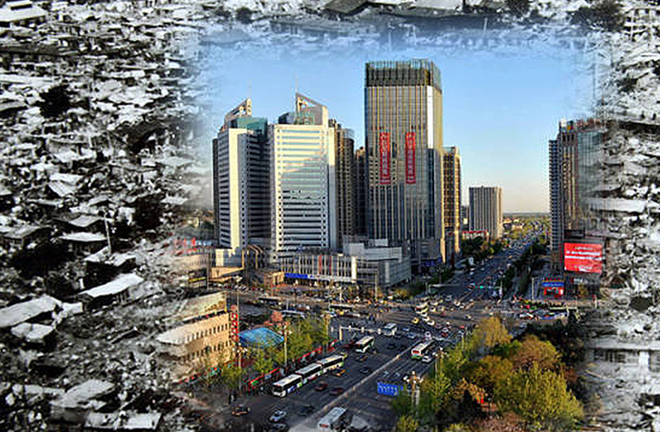Reconstruction progress in post-disaster years

The central urban area of Tangshan, once shattered into ruins by the earthquake, now has an entirely new appearance.
An embodiment of China’s modernization, Tangshan made many landmark achievements in the national manufacturing sector. The earthquake that struck the city in 1976 derailed its progress, but after four decades of reconstruction, Tangshan stands today as a testament to its people’s resolve.
Economic recovery
In recent years, the economy of Tangshan has taken off. Through periodic adjustments made to the structure of heavy industry, its economic development has soared in measurable terms, both quantitatively and qualitatively. A total of more than 1,000 large-scale pieces of machinery for scientific research have been installed in Tangshan in recent years, which has helped the city win the “2013 Outstanding Achievement for a Chinese Smart City Award.”
Some research institutes—such as the Tangshan Engineering Technology Center of High-Speed Multiple-Unit Trains—have obtained a number of patents and high-level awards for key technological breakthroughs. Some other key technologies that Tangshan possesses give the city an advantage. For example, the city is now home to the country’s most comprehensive specialized robotic production line, which uses specialized industrial robotics to replace workers in high-risk sectors of manufacturing.
According to a survey on sustainable development conducted in 2013, Tangshan ranks first among all 11 municipal cities in Hebei Province. A composite evaluation index has been formed using the following indicators: innovation, resource conservation, ecology, equality and management.
Sustainable development
However, the resourcefulness of Tangshan also hinders its development. Despite rapid economic growth, there are lingering social problems, such as excessive energy consumption and large amounts of pollution from heavy industries.
To achieve sustainable development, Tangshan is restructuring its economy and transitioning to an industrial model built on information technology. Advances in IT are being applied throughout the sectors of government, social management and economic transformation while a series of major projects that apply this technology in the fields of healthcare and transportation have been launched.
In its 13th Five-Year Plan, Tangshan highlights transformation as the key to building a modern industrial system. The first task is to fully capitalize on the advantages of the “Belt and Road” initiative and make Tangshan a focal point of cooperation in Northeast Asia. The second is to draw upon the advantages that Beijing, Tianjin and Hebei Province possess in talent, technology, information and capital to compensate for any of Tangshan’s weaknesses. The third is to revitalize the economic market with a focus on strategic emerging industries.
Liu Xueqian and Zhang Gongwei are from the Tangshan Development Institute at Chinese Academy of Sciences.
